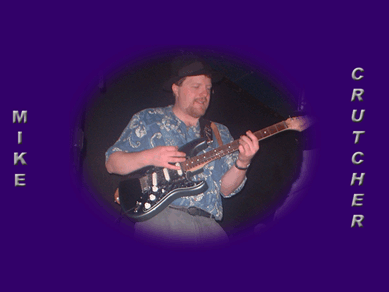Sounds cute, but is there any real thought behind it? It just means to play what you feel, right? Well, maybe, maybe not. When the current members of Trick Bag first got together, it was our bassplayer, Squid, who immediately stated,
what I find about this music is that it's really about the pocket...We all agreed, and we're making a lot of music together based on this principle. There's a lot of jazz influence in this concept, in that the music has to breathe and be human. That really entails the musicians really listening to what the other members are playing and reacting to it. This is not an easy task. There really aren't many exercises one can conduct to work on, other than pointing out in rehearsal pieces where you've done something in a solo and the band hasn't followed you. Recording your rehearsals is a good start.
I get ahead of myself. With this newfound listening task, one has to learn to enhance what the other players are doing, which may include laying out at the right times. One of the toughest things for a musician to learn to do is to not play. In our band, our goal is to be satisfied musically. There is a lot of solo space for everyone, but we try to keep things moving for the listener, too. One of the great things in playing music is sounding like a tight arrangement when improvising. Playing together enough to learn each others' licks and phrases is a part of it. When Mark, Squid, Dave, Zeke, etc. come to the end of a solo, I try to make sure I pick up on it and jump in with the tune as if we've rehearsed it. Some of it is guess work. Another part of it is for each member to be responsible for his own phrasing. When I feel like I've made my statement and that I'd like to finish up soloing, or even if I want to do a call-and-response with someone else, I tend to work to a frenetic point, and then slow down my notes, possibly heading to lower notes, signalling the end of what I'm playing. Same as when I'm accompanying; I play longer chordal pieces when I hear that Mark is coming out of his solo. It's like a musical conversation.
This groove thing is pretty abstract. Phrasing together is a big part. Learning to play ahead of the beat or behind the beat is another. When we talk about playing ahead of the beat, this means that we're playing a little early, just before the beat hits. Contrary to popular opinion, it is not the drummer's responsibility to keep the band in time. The drummer is a musician just like the rest of us. We're all responsible for our own timekeeping. I good drummer can certainly drag the rest of a band forward or backward in the groove, but I have also played way behind some drummers to keep them from rushing and speeding up the tempo. Try to listen for the kick drum and the snare hits and make mental note as to whether the drummer is behind or ahead of the beat.
Another issue for all to understand: swing, or shuffle grooves. I can't tell you how annoying it is to deal with the far too many musicians who don't understand what a shuffle is. The simple definition is when 8th note rhythms are uneven, with a long-short-long-short feel when the count would be 1+2+, etc. This can be considered a shuffle, a swing feel, a triplet feel, etc. This would mean that the 8th notes played would sound more like a "1+ah, 2+ah" feel. This would mean that the first 8th note (the "1") sounds twice as long as the 2nd 8th note (the "+"). This is, of course, a simplification. As tempos vary, the ratio of the length of the 8th notes change a bit, with the 8th notes being closer to even 8th notes at a faster tempo. In a jazz example, listen to saxophonist Charlie Parker and/or guitarist Pat Martino for closer-to-straight 8th notes at faster tempos. Many people play in this style, but don't necessarily understand what is different than straight 8th note tunes. They just play what they hear. However, this is a problem particularly when a group has to alternate between the two feels.
What's even less understood is a shuffle 16th note feel. Far less people understand this concept, but all have heard it. Trained drummers sometimes call this a half-time shuffle. That's an okay label; however, the tunes that this can be heard on are very obviously counted as "1-e-&-ah 2-3-&-ah..." etc. This would be where the first 16th note is longer than the 2nd 16th note. Much of New Orleans funk features this feel. It's standard to have different degrees of this shuffle, and it's important that all musicians in the ensemble can handle this groove. Listen to examples of The Meters' "Cissy Strut", Tower Of Power's "Credit", Ivan Neville's version of "Fortunate Son", etc. for examples of the 16th note shuffle, or the "funk shuffle." I'll try to record some examples of my own, but for now, try Youtube: http://www.youtube.com/watch?v=AYPTsPHXZUY
http://www.youtube.com/watch?v=wHyzijkTnfY
http://www.youtube.com/watch?v=wHyzijkTnfY
http://www.youtube.com/watch?v=ShHe7nh5mkc
It's all about the groove, baby!

